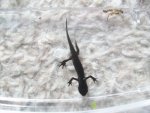hayleebee
New member
- Joined
- May 10, 2010
- Messages
- 1
- Reaction score
- 0
- Points
- 0
- Country
- United Kingdom
Hey guys, I recently bought a new cynops orientalis for a companion to my first, who i have had for a year and never had any problems with. Just after bringing the new one home, before adding him to my old newt, i noticed a swelling on his back leg, which has now turned into a wound and he has stopped using it, its limp and tends to stick to his side.
He is pretty perky and my old newt gets on well with him. I was just wondering what i can do to stop it getting infected? i dont really want to amputate (As its scary!) but will if i have to.
Also i havent seen him eat since i brought him home, he may have but i havent seen it happen.
Can anyone offer some advice? i really dont want to lose my new chum!
He is pretty perky and my old newt gets on well with him. I was just wondering what i can do to stop it getting infected? i dont really want to amputate (As its scary!) but will if i have to.
Also i havent seen him eat since i brought him home, he may have but i havent seen it happen.
Can anyone offer some advice? i really dont want to lose my new chum!


